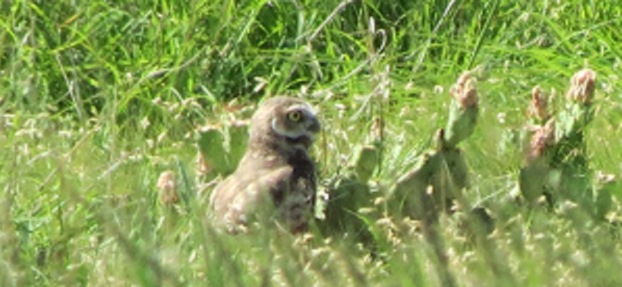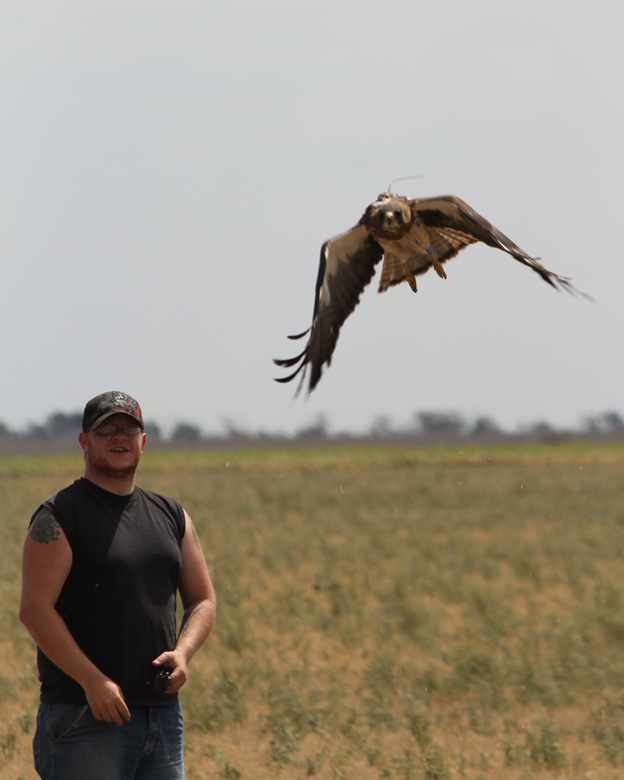Pantex Blog
Wild Pantex – Bird of the Day: The Dickcissel
Article by Jim Ray, Pantex Wildlife Biologist/Scientist
One of my favorite prairie birds is the Dickcissel. This native sparrow resembles a miniature meadowlark with its yellow breast and black bib. The Dickcissel’s name actually comes from the male's song –they spend a whole lot of time proclaiming their name and territory.
This summer, I had the pleasure of hearing a Dickcissel sing regularly as I walked from my car or work truck to the entryway to my office building. Several times while walking with someone I hollered out, "shhsh, hear that Dickcissel singing?" Of course, there was usually a wait period for the bird to sing again after the question rolled off my tongue. Normally, though, the Dickcissel didn't disappoint and soon announced his presence again.
The term Dickcissel usually puts a smile on the other person's face, maybe because with a name like that they think I must be pulling their leg. My next statement is invariably, "No, I am not kidding. These guys stay here to nest in these wetter years, and this was the second such notable year since I have worked out here.”
This native prairie sparrow likes the taller cover found here during our wetter years. Their nests are a bulky cup of weed and grass stems placed slightly above ground-level in dense grasses or in saplings. The nests are lined with finer grasses, rootlets and hair, upon which three to six unmarked, pale blue eggs are laid.
I first became familiar with the Dickcissel while attending graduate school in South Dakota. I lamented the fact (as a young wildlifer) that the state bird of South Dakota was an exotic bird – the Ring-necked Pheasant. Nevermind how much money the bird brings into the state's economy – state birds in this great nation should be native birds! In a prairie state it should be a good prairie bird!
"Which one," my summer technician once asked.
Since both of us thought that the Dickcissel was a great prairie bird, it was an easy choice! The Dickcissel is a great "bird of the day" designee. It is a welcomed visitor to our Wild Pantex, and the more years that we hear its voice, the better off we all are knowing that rainfall has been abundant here on the shortgrass prairie.

The shortgrass prairie is a productive ecosystem, including for ground-nesting songbirds. In some years, the Dickcissel makes irregular movements outside of its core breeding range to breed in surrounding areas of grassland.
Going pink from Texas to Tennessee
From Texas to Tennessee, Consolidated Nuclear Security employees were in the pink for October. More than 100 employees, friends and family members participated in the Susan G. Komen Race for the Cure in the two locations while other employees wore pink and even dyed their facial hair.

Pantex employees, friends and family members laced up their shoes for the Greater Amarillo Race for the Cure. CNS was a platinum sponsor of the event.
In Texas, about 75 Pantexans, friends and family members, including two breast cancer survivors, participated in the Greater Amarillo Race for the Cure. CNS contributed $2,500 to the Susan G. Komen Amarillo Affiliate as a platinum sponsor of the event and paid for employee registration. Curtis Chamberlain, a production manager, who ran in the event with his 11-year-old daughter, said it was a “good opportunity to spend quality time with her and support a worthy cause.”
In mid-October, Y-12 LiveWise hosted a women’s health fair and encouraged all employees to wear pink for breast cancer awareness. During the fair, employees could receive flu shots, participate in some health screenings and receive health information.

Employees, friends and family members from Y-12 prepared for the Knoxville Race for the Cure in the pre-dawn hours Oct. 24. (Photo by Big Orange Professional Photography)
A few weeks later in Tennessee, 33 Y-12ers joined the cause at the Knoxville Race for the Cure. CNS provided t-shirts for the runners in addition to covering employee registration fee. Shelia Scarfo of Y-12 participated with her two daughters. She said, “I walk with one of my daughters each year since my grandmother died from this disease, and my mother is a survivor.”
One Y-12 employee felt breast cancer awareness was worth significant attention and dyed his beard pink. Rodney Ryder, a lineman in Power Operations, dyed his beard pink noting “I have extended family members who are battling breast cancer.” When he went to a salon to inquire about dying it pink, the stylist agreed to do it (and provide any needed touch ups) for free, given the cause.
Ryder says all the teasing from co-workers is worth it. “When a woman tells me thank you or shares her story with me, I know my purpose of dying it was right. I’m thinking of doing it yearly,” he said.
Wild Pantex – Collaboration Produces Ninth Publication
Article by Jim Ray, Pantex Wildlife Biologist/Scientist
Yet another publication has come out of a research collaboration that studied black-tailed prairie dogs and western burrowing owls on and around the U.S. Department of Energy/National Nuclear Security Administration Pantex Plant from 2000–2005. Seven manuscripts have been published and two others have recently been accepted and are in publication.

Black-tailed prairie dogs at Pantex on alert.
Sixteen years ago, Pantex sought bids for a contractor to collaborate on research focusing on black-tailed prairie dogs and wildlife that are associated with habitat diversity promoted by the area consisting of burrows, short cover, bare-ground and a plant community that differs from the adjacent prairie. Pantex needed information for management decisions, and the black-tailed prairie dog was under review for federal listing as "threatened" following petitioning by one or more environmental groups. The western burrowing owl is dependent on prairie dogs for habitat (burrows and short cover) and is also attracted to the rich insect, amphibian, reptile, bird and small mammal communities that are known to inhabit prairie dog colonies.
The collaboration that ensued included Pantex, Texas Tech University and the U.S. Geological Survey's Texas Cooperative Fish and Wildlife Research Unit at Texas Tech. The Texas Parks and Wildlife Department also contributed, which allowed study sites located away from Pantex to be included, extending the study across the Southern High Plains. Several studies were initiated and conducted as multi-year, comprehensive research projects, and most have since been published in the peer-reviewed or refereed literature. There is also a popular article on burrowing owls that will appear in a magazine this winter.
So, what is the big deal? The work contributes to the information base on these two mentioned special status species and the habitat that prairie dog colonies provide to other species. Eight of the publications are peer-reviewed, which implies that the research was set up to yield scientific results, and scientists agree that interpretations will be valuable to conservation of the subject species and habitats. The popular article will share the work on the amazing little burrowing owl with birdwatchers and citizens — not at all unimportant to its conservation since prairie dog colonies constitute the owl's habitat, and prairie dogs, often considered a pest, are highly persecuted through control efforts. Most of all, the productivity of the collaboration that worked on the studies represents dedication to regional wildlife issues. Among the publications, there is a good mix of senior (first) authors being Pantex staff (three) and university staff (six).
Many thanks go out to the students, professors and cooperating landowners as well as the decision makers at Pantex. Altogether, these entities are great contributors to "Wild Pantex."
Titles of manuscripts, year and publication:
“Noteworthy distributional records of the prairie vole in the Texas and Oklahoma Panhandles,” 2003, Southwestern Naturalist
"Effects of radiotransmitter necklaces on behaviors of adult male western burrowing owls,” 2007, Journal of Wildlife Management
“Effects of human landuse on western burrowing owl foraging and activity budgets,” 2008, Journal of Raptor Research
“Association of black-tailed prairie dogs (Cynomys ludovicianus) with playa lakes and a new approach to estimating size of populations,” 2009, Southwestern Naturalist
“Small mammals and ground-dwelling invertebrates associated with active and controlled colonies of black-tailed prairie dogs,” 2009, Southwestern Naturalist
“Small mammals associated with colonies of black-tailed prairie dogs (Cynomys ludovicianus) in the Southern High Plains,” 2010, Southwestern Naturalist
“Avian use of black-tailed prairie dog colonies in shortgrass prairie,” 2015, Great Plains Research
“Factors influencing burrowing owl abundance in prairie dog colonies in the Southern High Plains of Texas,” in press, Journal of Raptor Research
“Tracking burrowing owls,” 2016, in press, Bird Watcher's Digest

Western burrowing owls are quite common in and near the prairie dog colonies on the Pantex facility.
Pantex Protective Force hailed as “well prepared, well trained”
In July and August, Pantex hosted the Office of Enterprise Assessments for a complete multi-topic inspection. The EA team consisted of approximately 100 subject matter experts in the topical areas of Safeguards and Security.

During the EA inspection, the Protective Force was required to perform a wide variety of tasks to demonstrate proficiency in protecting the site. During the inspection process, the Protective Force performed more than 250 limited scope performance tests. These tests included firearm proficiency, general knowledge testing, Special Nuclear Material recognition, use of deadly force, physical fitness proficiency and donning personal protective equipment. In most of these tests, the Protective Force performed at 100 percent according to the proficiency standards outlined in DOE Orders.
“During daily inspection update meetings, Protective Force management relayed comments that they had received by the EA team. Some of the comments included that the force was ‘well prepared,’ ‘well trained,’ ‘professional’ and ‘committed’ among other great remarks.” Audy Jones, Safeguards and Security Operations, said.
In the force‑on‑force portion of the inspection, the Protective Force was tested against a variety of simulated attack scenarios. These scenarios included an adversary team attacking the site at different hours of the day with a multitude of weapons using an array of tactics. The Protective Force was able to quickly recognize the threat to the site and, by following established plans developed within the guidelines outlined within the use of force policy, neutralize the adversary prior to them completing their mission.
“At the end of the exercise, the EA team stated that they should have videotaped the exercise as they had not witnessed this level of professionalism in an exercise at any of the sites they had visited previously. They went on to say that the bar has just been set for other sites.” said Michael Mitchell with Protective Force Operations and Training.
The EA team recognized the Pantex Protective Force their outstanding performance during the entire inspection. EA team members stated that Pantex is only the second site in the history of the inspection process to go through a complete multi-topic inspection and not receive any findings or issues in the final report.
Wild Pantex - Swainson’s hawks, narrow corridors and wind farms
Article by Jim Ray, Pantex Wildlife Biologist/Scientist
The four remaining satellite‑marked Swainson’s Hawks departed from their nesting territories and are well on their way south towards their wintering grounds in Argentina. The hawks are strung out in migration, with one each in Nicaragua, El Salvador, Guatemala, and Mexico.
Attrition has occurred due to mortality and exhausted battery lives. A number of them have been retrieved and will be refurbished for use next summer. West Texas A&M University, the USGS Cooperative Fish and Wildlife Research Unit at Texas Tech University and Pantex have data of activity related to wind farms gathered throughout the hawks’ annual life cycle, which includes in their nesting territories, along their migration pathways and in their winter territories in Argentina. This work serves as a major contribution to the U.S. Department of Energy/National Nuclear Security Administration’s accomplishments under Executive Order 13186, Responsibility of Federal Agencies to Protect Migratory Birds. Among other things, this executive order promotes research, partnerships and outreach.
Our data, when overlain with maps of wind farms in North, Central, and South America, has enabled us to develop risk models for this species. Combined, all of our marked birds migrate along a narrow path the whole distance between here and the wintering area in Argentina. Data from other regions, when combined with ours, suggest that the entire population of this species takes this same narrow corridor. Especially interesting is that this path includes traversing a narrow mountain pass in Central America. This also begs the question on how many other species and individual birds pass through this same pass. Wind farm proponents have also found this same pass to be suitable for development. Thus, risk models involving situations like this are of great conservation value.
We are now transitioning our work to see if fledgling/juvenile Swainson’s hawks take the same paths and use the same areas, and if windfarms pose more risks to the inexperienced youngsters. Juveniles do not nest and it is unknown how and where they spend the first two years of their lives.
We have other types of data based on before and after turbine installation, distances from turbines and habitat type. This applies to songbirds, bats, and of course, birds of prey. We even have productivity and prey delivery data from nests at various distances from turbines. Our data were useful when eagle survey data was requested by the U.S. Fish and Wildlife Service as part of our inquiry about the need for an Eagle Take Permit (accidental mortality of eagles at turbines).
These projects make up the latest of a long line of research projects on migratory birds that Pantex has worked on with universities, including those on western burrowing owls, purple martins and avian use of black‑tailed prairie dog colonies. These latest projects include monitoring associated with the Pantex Renewable Energy Project.

West Texas A&M University student Dustin Henderson releases a Swainson’s hawk that is sporting leg bands and a satellite transmitter. If you look closely, you can see the antenna coming off the bird’s back.
